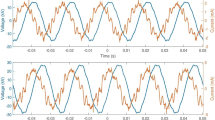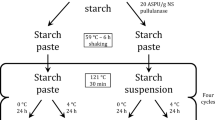Abstract
The handling of rice flour doughs in terms of sheeting, flattening and rolling is difficult due to the absence of gluten forming proteins; scope exists to improve these characteristics by incorporating appropriate additives during the preparation of rice doughs. Different levels of additives such as whey protein concentrate (WPC) (0–10 %), xanthan gum (0–5 %), sucrose (0–20 %) and salt (0–2 %) have been incorporated, and the rheological (small-deformation oscillation) as well as sensory characteristics have been determined, in addition to microstructural observations and finding inter-relationships. The second order polynomial can adequately explain the rheological parameters like storage modulus, loss modulus and complex viscosity (R = 0.863–0.889, p ≤ 0.01) while it is poor for phase angle (R = 0.659, p ≤ 0.01). Among these additives, xanthan gum imparts the strongest effect (significant at p ≤ 0.01) followed by whey protein concentrate. The effects of these additives are predominantly linear though quadratic effects are also significant in several cases. A cohesive microstructure with improved binding occurs with a high level (7.5 %) of WPC. It is concluded that a judicious selection of additives in appropriate levels can develop rice doughs that possess the desirable handling properties leading to preparation of products.




Similar content being viewed by others
References
AACC (2000) Approved methods of American association of cereal chemists, 10th edn. AACC International, St. Paul
Asghar A, Anjum FM, Butt MS, Tariq MW, Hussain S (2007) Rheological and storage effect of hydrophilic gums on the quality of frozen dough pizza. Food Sci Technol Res 13:96–102
Beck M, Jekle M, Becker T (2011) Impact of sodium chloride on wheat flour dough for yeast-leavened products. I Rheological attributes. J Sci Food Agric 92:585–592
Bhattacharya S, Bhat KK (1997) Steady shear rheology of rice-blackgram suspensions and suitability of rheological models. J Food Eng 32:241–250
Bhattacharya S, Jena R (2007) Gelling behavior of defatted soybean flour dispersions due to microwave treatment: textural, oscillatory, microstructural and sensory properties. J Food Eng 78:1305–1314
Bhattacharya S, Narasimha HV, Bhattacharya S (2003) Effect of gum Arabic on the rheology of corn flour doughs and fried product quality. J Texture Stud 34:421–436
Chang YH, Lim ST, Yoo B (2004) Dynamic rheology of corn-starch-sugar composites. J Food Eng 64:521–527
Conforti PA, Lupano CE (2004) Functional properties of biscuits with whey protein concentrate and honey. Intl J Food Sci Technol 39:745–753
Crockett R, Le P, Vodovotz Y (2011) How do xanthan and hydroxypropyl methylcellulose individually affect the physicochemical properties in a model gluten-free dough? J Food Sci 76:274–282
Farahnaky A, Hill SE (2007) The effect of salt, water and temperature on wheat dough rheology. J Texture Stud 38:499–510
Galal AM, Varriano-Marston E, Johnson JA, Chemistry C (1978) Rheological dough properties as affected by organic acids and salt. Cereal Chem 55:683–691
Indrani D, Prabhasankar P, Jyotsna R, Venkateswara Rao G (2007) Influence of whey protein concentrate on the rheological characteristics of dough, microstructure and quality of unleavened flat bread (parotta). Food Res Intl 40:1254–1260
Khuri AI, Cornell JA (1989) Response surfaces: designs and analyses. Marcel Dekker, New York
Lawless HT, Heymann H (eds) (1998) Sensory evaluation of food: principles and practices. Chapman & Hall, New York, pp 606–608
Lazaridou A, Duta D, Papageorgiou M, Belc M, Biliaderis CG (2007) Effects of hydrocolloids on dough rheology and bread quality parameters in gluten-free formulations. J Food Eng 79:1033–1047
Little TM, Hills FJ (1978) Agricultural experimentation: design and analysis. Wiley, New York, pp 247–266
Lupano CE (2000) Gelation of mixed systems whey protein concentrategluten in acidic conditions. Food Res Intl 33:691–696
Maache-Rezzoug Z, Bouvier JM, Allaf K, Patras C (1998) Effect of principal ingredients on rheological behaviour of biscuit dough and on quality of biscuits. J Food Eng 35:23–42
Matz SA, Matz TD (1978) Cookie and cracker technology, 2nd edn. The AVI Publishing Company, Westport, pp 36–39
Mi YK, Yeong HC, Hae CC (1997) Effects of gums, fats and glutens adding on the processing and quality of milled rice bread. J Korean Soc Food Sci Nutr 29(4):700–704
Nishita KD, Bean MM (1979) Physico-chemical properties of rice in relation to rice bread. Cereal Chem 56:185–189
Olkku J, Rha C (1978) Gelatinization of starch and wheat flour starch. Food Chem 3:293–311
Pereira CD, Díaz O, Cobos A (2007) Impact of ovine whey protein concentrates and clarification by-products on the yield and quality of whey cheese. Food Technol Biotechnol 45(1):32–37
Peressini D, Sensidoni A (2000) Rheology of wheat doughs for fresh pasta production: influence of semolina-flour blends and salt content. J Texture Stud 31:163–168
Preston KR (2001) Effects of neutral salts of the lyotropic series on the physical dough properties of a Canadian red spring wheat flour. Cereal Chem 66:144–148
Rosalina I, Bhattacharya M (2001) Flow curves, stress relaxation and creep measurement of starch gels. J Texture Stud 32:247–269
Rosell CM, Rojas JA, Benedito C (2001a) Influence of hydrocolloids on dough rheology and bread quality. Food Hydrocoll 15:75–81
Rosell CM, Rojas JA, Benedito C (2001b) Combined effect of different antistaling agents on the pasting properties of wheat flour. Eur Food Res Technol 212:473–476
Saha S, Bhattacharya S (2010) Hydrocolloids as thickening and gelling agents in food: a critical review. J Food Sci Technol 47:587–597
Sahraiyan B, Naghipour F, Karimi M, Davoodi MG (2013) Evaluation of Lepidium sativum seed and guar gum to improve dough rheology and quality parameters in composite rice-wheat bread. Food Hydrocoll 30:698–703
Salvador A, Sanz T, Fiszman SM (2005) Dynamic rheological characteristics of wheat flour–water doughs. Effect of adding NaCl, sucrose and yeast. Food Hydrocoll 20:780–786
Shalini KG, Ananthanarayan Laxmi A (2007) Influence of additives on rheological characteristics of whole-wheat dough and quality of chapatti (Indian unleavened flat bread). Part I—hydrocolloids. Food Hydrocoll 21:110–117
Shittu TA, Aminu RA, Abulude EO (2009) Functional effects of xanthan gum on composite cassava-wheat dough and bread. Food Hydrocoll 23:2254–2260
Sivaramakrishnan HP, Senge B, Chattopadhyay PK (2004) Rheological properties of rice dough for making rice bread. J Food Eng 62:37–45
Sozer N, Kaya A, Dalgic AC (2008) The effect of resistant starch addition on viscoelastic properties of cooked spaghetti. J Texture Stud 39:1–16
Sudha ML, Rajeswari G, Rao GV (2010) Influence of defatted soy flour and whey protein concentrate on dough rheological characteristics and quality of instant vermicelli. J Texture Stud 42:72–80
Tiwari S, Ravi R, Bhattacharya S (2012) Dehumidifier assisted drying of a model fruit pulp-based gel and sensory attributes. J Food Sci 77:S262–S273
Ylimaki G, Hawrysh ZJ, Hardin RT, Thomson ABR (1988) Application of response surface methodology to the development of rice flour yeast breads: Objective measurements. J Food Sci 53:1800–1805
Author information
Authors and Affiliations
Corresponding author
Rights and permissions
About this article
Cite this article
Dixit, Y., Bhattacharya, S. Rheological and sensory behaviour of rice flour dough: effect of selected additives in relation to dough flattening. J Food Sci Technol 52, 4852–4862 (2015). https://doi.org/10.1007/s13197-014-1591-4
Revised:
Accepted:
Published:
Issue Date:
DOI: https://doi.org/10.1007/s13197-014-1591-4




